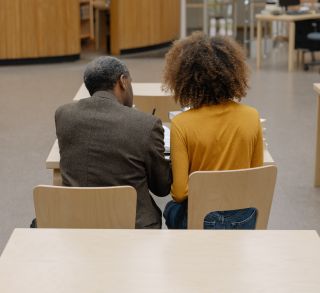Education
A Brand-New Look: Higher Education in the Post-Pandemic Era
Integrating "growth-speak" into everything we do in the classroom.
Posted August 16, 2023 Reviewed by Davia Sills
Key points
- Mindset involves much more than positive thinking; it is a filter for organizing incoming information.
- Mindset brings along narratives, and these can impact one negatively or drive the motivation to improve.
- Failure is an illusion; it is about people moving around, creating results that point us in a new direction.
Let’s face it: In the now post-pandemic era, higher education is in desperate need of a facelift. Plain and simply put, the way we have been doing things for years is no longer working, and we need to revamp our approach if we are going to continue to make a difference in the lives of young adults, preparing them for a world that is now more uncertain than ever.
As we are well aware, mindset is everything, and in order to help our young adults make a shift in their perspectives, as educators, we need first to take that big leap to make a shift in how we view things ourselves. We need to completely change it up and approach both education and assessment from an entirely different angle.

To begin, we need to revisit the concepts of the fixed versus growth mindset, first coined by Carol Dweck over two decades ago. Dweck’s work first opened the eyes of educators back in the late ’90s and early 2000s, and in my opinion, her work is needed now more than ever (Dweck, 2007). This is primarily due to the fact that mindset is larger than simply what we allow to run through our minds. According to Dr. Alia Crum of Stanford University, “Mindsets are core assumptions we make about the things and processes in the world that orient us to a particular set of expectations, explanations, and goals.”
Basically, our mindset leads us to shift our attention to one thing while shifting it away from another, and we can train the brain to do this on command. Mindset is also a vehicle for organizing incoming information, and this is where the sweet spot for making lasting change resides. This is where our focus needs to be as post-pandemic educators.
In addition, mindset brings along narratives like barnacles on the brain, and this is also where we can assist our students with monitoring the daily narratives rolling through their minds. We need to teach them how to become the boss of their brain, which means fully comprehending that thoughts come first and feelings second and that our thoughts dictate how we feel. They need to grasp the fact that they cannot feel insecure without thinking insecure thoughts first. Once they understand this, they will realize the importance of being aware of their thoughts and cherry-picking the ones they allow to stay.
By doing so, young adults will become aware that these narratives can not only impact performance negatively but can also serve to drive their ability to make progress. How do we do this? With feedback. Feedback shapes progress.

The first step, then, is to help students distance their identity from the challenges they are facing. This means helping them break away from the old messages locked in their hard drive, such as being labeled as the smart one, the good athlete, the amazing musician or artist, etc.
These represent fixed mindsets as they are attached to performance rather than effort, and in doing so, can actually undermine what a student is capable of, especially if they are a high-performing super-achiever.
Rather than attaching their identities to performance and academic, athletic, or creative outcomes, we can instead guide them to attach their identities toward an authentic sense of motivation and effort. This will, in turn, steer them toward a new perspective: that focusing on overcoming challenges and improving is part of the genuine and pure joy of learning. This is what it’s all about, teaching our young adults how to be actively engaged in and enjoying their lives while also moving forward.
We can be instrumental in making this happen by role-modeling the importance of effort in the classroom while also consistently providing feedback on student assessments based on effort rather than performance. In fact, Carol Dweck found in her work with students that those who had been effort-praised rather than performance-praised sought out more challenging problems and questions. The performance-praised students often avoided more difficult problems and questions altogether for fear of not living up to their assigned labels (Dweck, 2007).
Josh Blumberg of Champlain College explains, "The difference in performance is significant. This research extends further to show that the attitude that both the student and faculty members have toward learning really matters. If they both approach learning with an attitude that anyone can improve their intelligence through discipline and hard work, then the student outcomes will improve." The bottom line is that perseverance talk will motivate students to seek out more difficult challenges, and this is exactly what our young adults need right now.
From a cognitive psychological perspective, this is neuroplasticity at its finest, rewiring the brain for lasting change. Another cool thing happening simultaneously is something referred to as neural pruning, which means that while new, positive pathways are being strengthened, the old, negative ones are falling away due to a lack of use. This concept is similar to pruning the dead branches off our front-yard bushes in the spring. By trimming away what is no longer of use, we make room for new growth.
Also, the growth mindset brings a new perspective on what it means to fail, and we can help our students with this as well. I know from teaching young adult college students for nearly 14 years that the fear of failure is at the forefront of their minds and very much rooted in the fixed mindset. When we think about this, it is important to realize two things; first, that rarely does anything positive come from fear unless it involves an immediate escape from danger. In fact, when a student is locked into “limbic system” mode, which is, of course, the headquarters for fear, very little (if any) new information is getting in. Zero. This means that our effort as educators is completely in vain.

Next, we can teach them a whole new perspective on failure, which is that it doesn’t really exist. Dr. Wayne Dyer says this best when he explains, “Failure is an illusion. It is about people moving around and producing results that point us in a new direction.” That’s it. He then goes on to say that our focus should be on attitude and the decisions we make as far as what to do with the results we have produced.
By helping to recondition our young adults to view the concept of failure as part of the fluid process of learning rather than something to be harshly judged, we will also help them to move away from the rigid expectations that feed their anxiety like Miracle-gro.
References
Dweck, C. (2007). Mindset: The new psychology of success-how we can learn to fulfil our potential. New York, NY: Ballentine Books.
Dyer, W. (2018). You are what you think: 365 meditations for extraordinary living. New York, NY: Hay House.
Huberman, A. (n.d.). Dr. Alia Crum: Science Of Mindsets For Health & Performance | Huberman Lab. Retrieved
from: https://podcastnotes.org/huberman-lab/episode-56-dr-alia-crum-science-o…
Huberman, A. (n.d.) How to Enhance Performance & Learning by Applying a Growth Mindset. The Huberman Lab podcast. Retrieved from:
https://hubermanlab.com/how-to-enhance-performance-and-learning-by-appl…
Mueller, C. M., & Dweck, C. S. (1998). Praise for intelligence can undermine children's motivation and performance. Journal of Personality and Social Psychology, 75(1), 33–52. https://doi.org/10.1037/0022-3514.75.1.33




